It is not easy to prepare for the SAT, but when you narrow it down to a specific section, such as geometry, it will make your study sessions more effective. Here, we provide an extensive list of SAT geometry questions to help you practice and improve your score. Don’t forget to keep a clock nearby and set a timer of 55 minutes for an efficient result!
Practice Questions
Angles
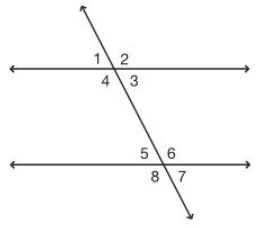
1. If the measure of angle 2 is equal to 12x + 10 and the measure of angle 8 is equal to 7x – 1, what is the measure of angle 2?
a) 9°
b) 62°
c) 108°
d) cannot be determined.
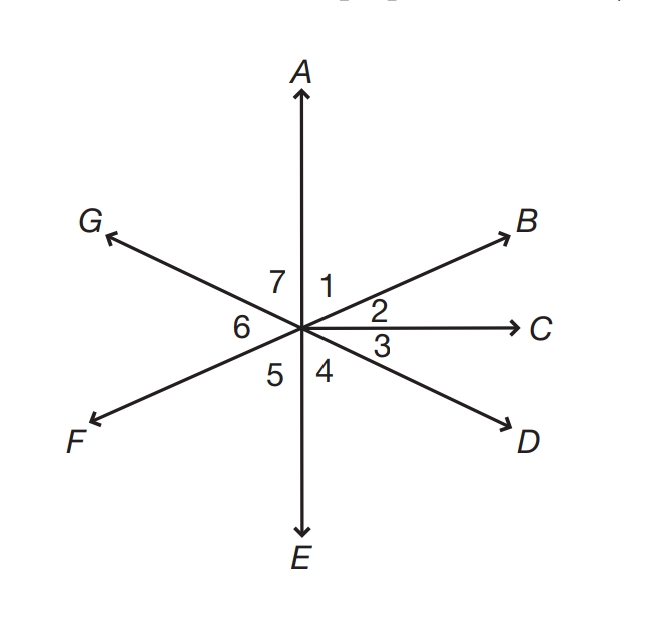
2. If the measure of angle 3 is 2x + 2 and the measure of angle 4 is 5x – 10, what is the measure of angle 7?
a) 14°
b) 30°
c) 60°
d) 90°
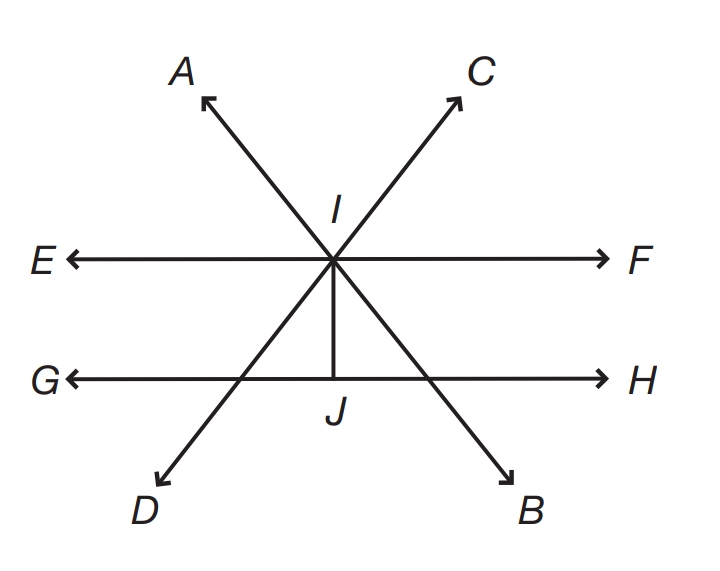
3. If angles LIF and EIK are congruent, and the measure of angle LIF is 6 greater than the measure of angle JIL, what is the measure of angle KIJ?
a) 42°
b) 48°
c) 54°
d) 87°
Triangles
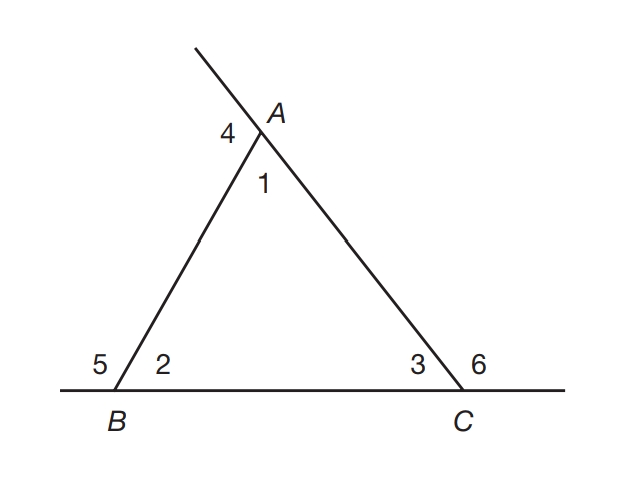
4. If angle 6 measures 115° and angle 2 measures 75°, what is the measure of angle 4?
a) 75°
b) 105°
c) 115°
d) 140°
5. The measure of an angle exterior to angle F of triangle DEF measures 16x + 12. If angle F measures 8x, what is the measure of angle F?
a) 7°
b) 49°
c) 56°
d) 102°
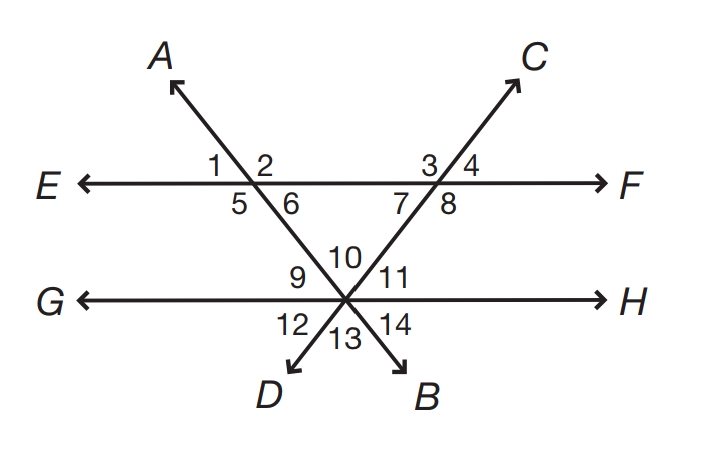
6. If the triangle formed by lines AB, CD, and GH is an isosceles right triangle, angle 8 is greater than angle 7, and angle 8 is congruent to angle 5, which of the following is NOT true?
a) angle 2 = angle 9 + angle 12
b) angle 13 = 90°
c) Angles 11 and 14 are complementary.
d) angle 1 = angle 4
Want to know the Answers? Find it here
Polygons
7. The sum of the interior angles of a polygon is 9x² If x is 3 greater than the number of sides of the polygon, how many sides does the polygon have?
a) 6 sides
b) 7 sides
c) 10 sides
d) 12 sides
8. Polygon ABCDEF is similar to polygon GHIJKL. If side AB is 12x + 6x and side GH is 8x + 4x, and these sides are corresponding sides, what is the ratio of the perimeter of polygon GHIJKL to the perimeter of polygon ABCDEF?
a) 1:3
b) 2:1
c) 2:3
d) 3:1
9. If the sum of the interior angles of a regular polygon equals 720°, and the length of one side of the polygon is 3x², what is the perimeter of the polygon?
a) 18x² units
b) 24x² units
c) 14x² units
d) 27x² units
Coordinate Geometery
10. What is the midpoint of a line segment with endpoints at (0,–8) and (–8,0)?
a) (–8,–8)
b) (–4,–4)
c) (–1,–1)
d) (4,4)
11. What is the distance from the point (–6,2) to the point (2,17)?
a) 3√41 units
b) √229 units
c) 17 units
d) √365 units
Want to improve your score? Challenge yourself with 20 Hardest SAT Math Questions Ever
12. Which of the following lines is perpendicular to the line given by the equation y = – (⅙)x+ 8?
a) y = –6x – 8
b) y = –6x + 8
c) y = (⅙)x – 8
d) y = 6x + 8
3D Shapes
13. Terri fills with water 2/3 of a glass that is 15 cm tall. If the radius of the glass is 2 cm, what volume of water is in Terri’s glass?
a) 10π cm³
b) 20π cm³
c) 30π cm³
d) 40π cm³
14. The radius of a cylinder is 2x and the height of the cylinder is 8x + 2. What is the volume of the cylinder in terms of x?
a) (16x² + 4x)π
b) (16x³ + 4x²)π
c) (32x²+ 8x)π
d) (32x³ + 8x²)π
15. The height of cylinder B is three times the height of cylinder A, and the radius of cylinder B is 1/3 the radius of cylinder A. Which of the following statements is true?
a) The volume of cylinder B is 1/9 the volume of cylinder A.
b) The volume of cylinder B is 1/3 the volume of cylinder A.
c) The volume of cylinder B is the same as the volume of cylinder A.
d) The volume of cylinder B is 3 times the volume of cylinder A.
- (a)
- (c)
- (a)
- (d)
- (c)
- (a)
- (b)
- (c)
- (a)
- (b)
- (c)
- (d)
- (d)
- (d)
- (b)
SAT Math Section Overview
Before we proceed, let us have a look on how the SAT Math section is divided into two modules:
Module 1:
- Number of Questions: 22
- Time Allotted: 35 minutes
- Focus Areas: A mix of Algebra, Advanced Math, Problem Solving & Data Analysis, and Geometry & Trigonometry with easy, medium, and hard questions.
Module 2:
- Number of Questions: 22
- Time Allotted: 35 minutes
- Focus Areas: Similar content areas as Module 1, but the difficulty level adapts based on the test-taker’s performance in Module 1.
Breakdown of Question Types
|
Geometry questions make up the fourth category, and they make up approximately 10% of the SAT math test, or around 5–7 questions. You’re expected to know basic geometric concepts, such as the properties of angles, shapes, and solids. However, you are provided with a few formulas to help you solve these problems: |
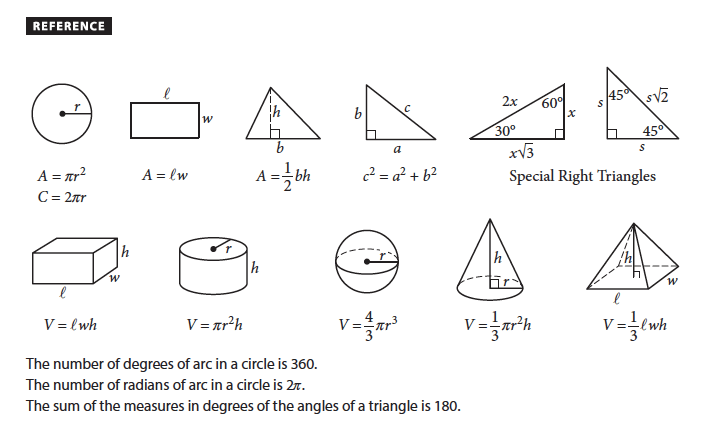
However, we do suggest that you memorize these formulas. This will not only save you the time of flipping back and forth through your test booklet, but will also give you an idea of where to start when encountered with an unfamiliar problem.
Patterns in SAT
- Multiple Choice Questions: Most questions provide four answer choices.
- Grid-In Questions: Students provide their own numerical answers for these questions (no options are given).
- Difficulty Levels: Questions are primarily listed from easiest to hardest under each heading.
Geometry Concepts Addressed
- Angles: Complementary, supplementary, and vertical angles.
- Triangles: Special right triangles, triangle inequality, and Pythagorean theorem.
- Polygons: Interior and exterior angles, perimeter, and area.
- Coordinate Geometry: Slope, distance, and equations of lines.
- 3D Shapes: Volume and surface area.
Conclusion
The mastery of SAT geometry comes only with regular practice. Use these questions to hone your geometry skills and accelerate your problem-solving process. Practice gets perfect-only, after all-start today!
Want to excite your child about math and sharpen their math skills? Moonpreneur’s online math curriculum is unique as it helps children understand math skills through hands-on lessons, assists them in building real-life applications, and excites them to learn math. You can opt for our Advanced Math or Vedic Math+Mental Math courses. Our Math Quiz for grades 3rd, 4th, 5th, and 6th helps in further exciting and engaging in mathematics with hands-on lessons.
FAQs About SAT Geometry
A: Geometry questions are part of “Additional Topics in Math” and represent about 10% of the SAT Math section or 5-7 questions.
A: The SAT tests all of the usual, fundamental ideas about the properties of angles, shapes and solids. They provide some formula in the test to fill in or even memorize during the exam as it helps to save a lot of time and assist in solving other problems.
A: Yes calculator is allowed in all types of questions in both modules of the Math Section.
A: Practice regularly and focus on understanding the underlying concepts.







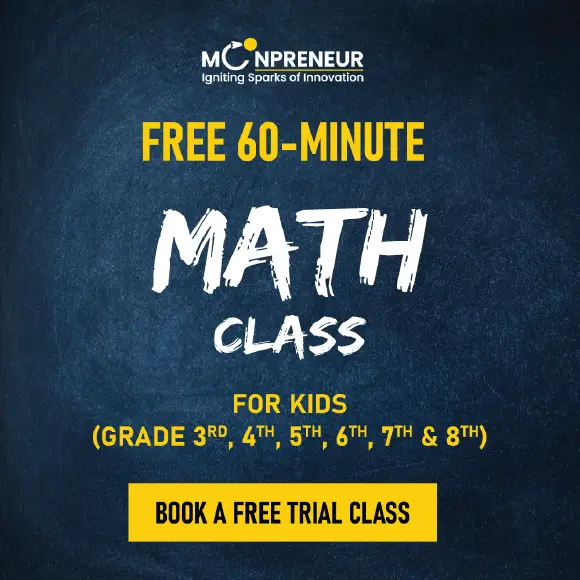




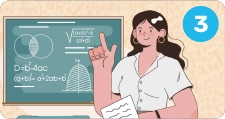
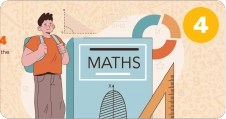
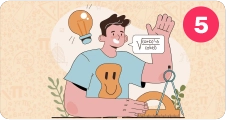
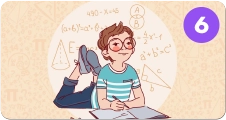

This blog discusses good questions. Can you please provide some additional questions based on 3D shapes?
How do I obtain a good SAT Math score if I have weak Geometry concepts?
That‘s a good question! If geometry is not your best subject, don‘t panic—you can still raise your SAT Math score by concentrating on algebra, problem-solving, and data analysis. We’ve touched on some really useful tips in our blog How to Increase Your SAT Math Score from 500-600—including advice on how to solve tricky geometry problems even if you are not 100% sure.). Take a look and let us know if you have any particular questions.